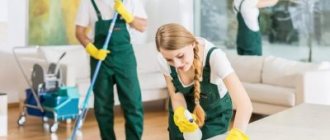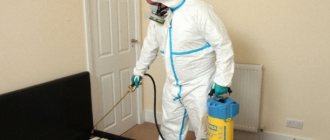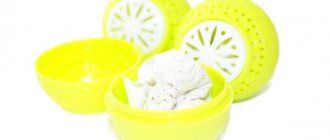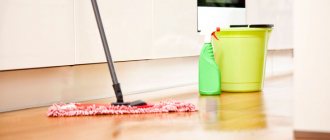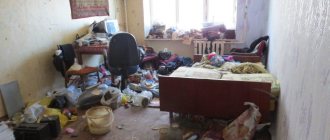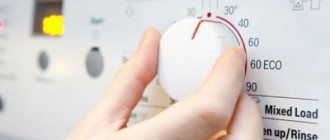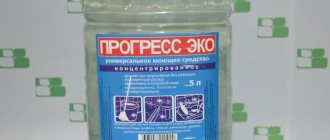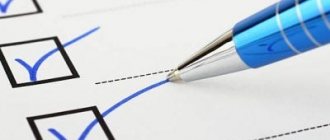Carrying out general cleaning is an absolute necessity in all catering establishments, children's and medical institutions. It can be performed by staff or by a professional company. In the second case, many advantages await, and the price of the work will be low and affordable for everyone. The key feature of such work is the availability of specialized equipment and detailed adherence to sanitary and epidemiological standards. Cleaning is carried out in all institutions on an ongoing basis - daily and more thorough (general) - once a week.
Why does a cleaner need instructions?
Cleaner is one of the most common professions.
It can be found in the staffing table of any company. ConsultantPlus experts explained in detail how the staffing arrangement is drawn up. Get trial demo access to the K+ system and go to the HR Guide for free.
A cleaner's job description (JDU) is a full-fledged document from a set of similar instructions, the presence of which is necessary to regulate the relationship between the employer and the employee.
IMPORTANT! The functional responsibilities of an office cleaner can be specified both in the employment contract (Article 57 of the Labor Code of the Russian Federation) and in the labor management agreement (Article 8 of the Labor Code of the Russian Federation).
There are usually no qualification requirements for the cleaning profession - level of education or work experience do not play a special role. Other qualities that are important here are scrupulousness, cleanliness, patience and endurance.
IMPORTANT! DIU takes on special significance if the premises for which the employee is responsible for the cleanliness have specific properties.
For example, the DIU for house cleaners will look different:
- industrial;
- warehouse;
- public;
- office;
- food production;
- technical.
In addition, the maintenance of the maintenance facility will be different if cleaning is provided not inside the office premises, but on the company’s territory (or the cleaner is assigned both the territory and all office premises).
Thus, it is in the interests of both parties to the employment contract that every employee in the company is familiar with their job description, including the office cleaner.
Instructions
on disinfection of premises during coronavirus
___________________
General provisions
1.1. This instruction has been developed on the basis of the Letter of Rospotrebnadzor dated January 23, 2022 No. 02/770-2020-32 “On instructions for carrying out disinfection measures to prevent diseases caused by coronaviruses.” The instructions apply to all workers involved in disinfection and treatment of premises.
1.2. This instruction contains the basic requirements for disinfection of premises in an institution (organization) and personal hygiene of workers, features of preventive measures, sanitary treatment of premises, provision of workers with protective equipment and other necessary measures to counter the spread of the new coronavirus infection (COVID-19).
1.3. Due to the unfavorable situation regarding the new coronavirus infection, employees (cleaners, cleaning company specialists) are allowed to work after undergoing unscheduled training on studying preventive measures to prevent the spread of infection, studying these instructions in detail, and observing all precautions.
1.4. Service personnel must follow the instructions for disinfecting premises during coronavirus infection and have permission to work.
1.5. Preventive disinfection begins immediately when a threat of disease arises in order to prevent the penetration and spread of the pathogen into groups of people at facilities, territories, etc., where this disease is absent, but there is a threat of its introduction from the outside.
1.6. According to the recommendations of Rospotrebnadzor, products from various chemical groups can be used for disinfection:
- chloroactive (sodium salt of dichloroisocyanuric acid - in a concentration of active chlorine in the working solution of at least 0.06%, chloramine B - in a concentration of active chlorine in the working solution of at least 3.0% );
- oxygen-active (hydrogen peroxide in a concentration of at least 3.0% );
- cationic surfactants (CSAS) - quaternary ammonium compounds (at a concentration in the working solution of at least 0.5% );
- tertiary amines (at a concentration in the working solution of at least 0.05% );
- polymeric derivatives of guanidine (at a concentration in the working solution of at least 0.2% );
- alcohols (as skin antiseptics and disinfectants for treating small surfaces - isopropyl alcohol in a concentration of at least 70% by weight , ethyl alcohol in a concentration of at least 75% by weight ).
The procedure for using individual disinfectants recommended by Rospotrebnadzor authorities and disinfection regimes are given in the instructions for use of the products used.
1.7. In order to comply with the requirements to prevent the spread of the new coronavirus infection, workers must:
- strictly follow the recommendations of Rospotrebnadzor on preventing the spread of coronavirus COVID-19 on the territory of the organization (institution), in production, auxiliary and household premises;
- notify about any deviations in health status. An employee with symptoms of the disease is not allowed to work and is sent to a medical facility. Renewal of permission to work is possible only if there is a certificate of recovery from a medical institution;
- keep your workplace and cleaning equipment tidy and clean;
- assist and cooperate with the employer in ensuring healthy and safe working conditions, immediately report to your immediate supervisor or other official about any deterioration in your health, incl. about the manifestation of signs of a new coronavirus infection;
- comply with all labor safety standards and obligations established by the collective agreement, agreement, employment contract, internal labor regulations, job responsibilities;
- perform your job duties carefully and not be distracted;
- use and correctly apply PPE, disposable masks, disposable gloves, skin antiseptics for hand treatment, disinfectants according to the conditions and nature of the work performed;
- in the absence of protective equipment and disinfectants, immediately notify your direct supervisor about this;
- immediately notify your direct or superior manager about any situation that poses a threat to the life or health of employees and others, about an accident that has occurred, or about a deterioration in your health;
- adhere to all requirements and regulations to prevent the spread of the new coronavirus infection;
- know the routes of transmission, signs of the disease, measures to prevent coronavirus infection.
1.8. Workers should know that the mechanisms of transmission of coronavirus infection are airborne, contact, and fecal-oral routes.
1.9. Workers are provided, in accordance with established standards, with sanitary clothing, sanitary footwear, sanitary supplies, and disinfectants.
1.10. Service personnel involved in disinfection of premises must:
- store sanitary clothing and footwear in designated places;
- leave outerwear, shoes, hats, as well as personal items in the wardrobe;
- perform work exclusively in clean sanitary clothing and change it when soiled;
- strictly observe personal hygiene measures;
- change masks at least once every 3 hours;
- treat hands with disinfectants;
- have a supply of disinfectants and necessary technical equipment in sufficient quantity.
1.11. In order to prevent and prevent the spread of coronavirus infection, gastrointestinal, parasitic and other diseases, workers need to know and strictly observe the rules and regulations of personal hygiene:
- cut your nails short and do not apply polish on them;
- wash your hands thoroughly with soap (which has a disinfectant effect) before starting work, moving from one operation to another, after a break from work, after touching contaminated objects, as well as after visiting the bathroom, before eating and at the end of work.
1.12. Maintenance personnel are responsible for compliance with the requirements of these instructions for disinfecting premises during coronavirus infection in accordance with the legislation of the Russian Federation.
- Sanitary and hygienic requirements before starting preventive disinfection
2.1. The organization (institution) has adopted local regulations to prevent the spread of the new coronavirus infection, compliance with which is mandatory for all employees.
2.2. Systematic work has been organized to inform employees about the risks of the new coronavirus infection COVID-19, personal prevention measures, and the need to timely seek medical help when the first symptoms of ARVI appear.
2.3. Based on existing documents and recommendations of Rospotrebnadzor, personal hygiene rules, cleaning regulations, and instructions for the use of disinfectants have been developed and sent to employees.
2.4. In order to prevent and combat coronavirus (COVID-19), preventive and ongoing disinfection is carried out. To carry out disinfection, disinfectants are used that are registered in accordance with the established procedure in the Russian Federation. The Instructions for the use of these products indicate modes for disinfecting objects during viral infections.
2.5. Before starting work, all workers have their body temperature measured by the responsible person (medical worker) and recorded in a thermometry log.
2.6. At a temperature of 37.0 and above, or with other obvious signs of ARVI, the employee is removed from work and sent home to call a medical professional at home.
2.7. Before starting work, the organization's service personnel are provided with a supply of disposable masks (based on the duration of the work shift and changing masks at least once every 3 hours), disposable gloves for use during work, as well as disinfectant wipes, or skin antiseptics for hand treatment, disinfectants . Reuse of disposable masks, as well as the use of moistened masks, is not allowed.
2.8. Workers are required to comply with the rules of personal hygiene and industrial sanitation.
2.9. Before starting work, you must wash your hands. To mechanically remove contaminants and microflora, wash hands with warm running water and soap for 1-2 minutes, including after using a cell phone, paying attention to the periungual spaces. It is optimal to use varieties of soap with high foaming ability. Hands are then rinsed with water to remove soap and treated with disinfectants (antibacterial hand sanitizers containing at least 60% alcohol (wet wipes or gel)).
2.10. Wear special clothing, special shoes, a disposable face mask, and rubber gloves.
2.11. All types of work with disinfectants should be performed using waterproof, disposable or reusable gloves.
2.12. Before disinfection, you should prepare (dilute) a working solution of the disinfectant in a container according to the antiviral regime specified in the instructions for the product used. In a separate container, prepare a working solution of disinfectant for periodic hand treatment during the disinfection process.
2.13. Separate cleaning equipment (rags, containers for diluting the working solution, etc.) should be prepared for each room to be cleaned.
2.14. Disinfectants should be stored in the manufacturer's packaging, tightly closed in a specially designated dry, cool and dark place, out of reach of others. Precautionary measures when carrying out disinfection measures and first aid in case of accidental poisoning with a disinfectant are set out for each specific disinfectant in the Instructions for their use.
- Sanitary and hygienic requirements during preventive disinfection of premises to prevent the spread of coronavirus infection
3.1. Preventive disinfection is carried out on a systematic basis and includes personal hygiene measures, frequent hand washing with soap and treating them with skin antiseptics, disinfection of tableware and kitchen utensils, ventilation and air disinfection, and wet cleaning of premises using disinfectants.
3.2. Disinfection should begin with cleaning cleaner rooms (studies, offices) and ending with more contaminated ones (halls, stairwells, corridors, bathrooms).
3.3. If possible, disinfection should be carried out simultaneously with ventilation.
3.4. Use a rag soaked in a prepared disinfectant solution to wipe the surfaces of tables, keyboards, window sills, switches, furnishings, and equipment.
3.5. After surface treatment, used rags and napkins must be placed in a separate garbage bag.
3.6. Treat gloved hands for 1-2 minutes in the prepared disinfectant solution.
3.7. Start processing the floors.
3.8. During preventive disinfection of sanitary facilities, the surfaces of switches, water taps, washbasins, and toilets should be thoroughly treated.
3.9. Disinfection of all contact surfaces (switches, door handles and handrails, railings, surfaces of tables and chair backs, office equipment) is carried out every 2-4 hours.
3.10. In the case of disinfection using the irrigation method, the following personal protective equipment (PPE) is used: the respiratory organs are protected with a respirator, the eyes are protected with goggles, or anti-aerosol respiratory PPE with an insulating face part is used.
3.11. Rules for using a disposable medical mask:
- wear a mask when performing preventive or routine disinfection work;
- Before you take the mask into your hands, you should treat them with an alcohol-containing product or wash them with soap;
- The mask should be put on so that it covers the mouth, nose, chin and is tightly fixed (if there are ties on the mask, they should be tied tightly). If one of the surfaces of the mask is colored, then the mask is put on with the white side facing the face;
- special folds on the mask should be unfolded, the sewn-in flexible plate in the nose area should be pressed tightly against the back of the nose to ensure a tighter fit to the face;
- use the mask once, reuse of the mask is unacceptable;
- The mask must be changed every 3 hours or more often. If the mask becomes wet, it should be immediately replaced with a new one;
- after using the mask, throw it into a bag that is tightly tied, and then throw it into a waste bag;
- remove gloves and wash hands with soap (30-40 seconds);
- after washing, hands should be treated with an alcohol-containing skin antiseptic;
- After washing your hands, if necessary, put on a new mask.
3.12. When working to disinfect premises, you should follow the instructions on labor protection when cleaning premises, the instructions for disinfecting the premises of an organization during coronavirus infection, and the precautionary measures given in the operational documentation of the manufacturer of disinfectants.
- Algorithm of action in case of suspicion of a new coronavirus infection
4.1. An employee who is suspected of contracting the new coronavirus infection COVID-19 notifies his immediate supervisor about his condition.
4.2. If there is a suspicion of a new coronavirus infection, COVID-19, send a call to a specialized mobile ambulance team and facilitate the referral of the patient to medical organizations that provide medical care in an inpatient setting.
4.3. Use bactericidal irradiators or other devices for disinfecting air and (or) surfaces to disinfect the air environment of the room (if available). If necessary, ensure that premises are disinfected by a specialized organization.
4.4. If sick people are identified, after removing the patient and clearing the premises of people, disinfection is carried out by specialized organizations. For processing, the most reliable disinfectants based on chloroactive and oxygen-active compounds are used. All surfaces, equipment and inventory of production premises, dining rooms, and bathrooms are subject to disinfection. The patient's dishes contaminated with food debris are disinfected by immersing them in a disinfectant solution and only then thoroughly washed with running water for 10 minutes. When treating surfaces, the irrigation method is used. It is recommended to treat the air in the absence of people using open portable ultraviolet irradiators and aerosols of disinfectants.
4.5. If an employee is confirmed to be infected with the new coronavirus infection COVID-19, the authorized official generates information about the employee’s contacts in the performance of official duties over the last 14 days and notifies the manager and all employees included in the list of the need to comply with the self-isolation regime.
- Sanitary and hygienic requirements upon completion of preventive disinfection in premises to prevent the spread of coronavirus
5.1. Cleaning equipment should be soaked in a disinfectant solution using the immersion method, then dried and stored in a designated place.
5.2. After carrying out preventive disinfection, service personnel must:
- treat rubber shoes with napkins or rags soaked in a disinfectant solution, place the used rags or napkins in a separate trash bag;
- treat gloved hands with a working disinfectant solution (1-2 min.), prepared in advance in a separate container and used only for treating gloved hands;
- remove the protective clothing (suit), fold it from the outside inward and place it in a disposable bag, followed by soaking in a disinfectant solution;
- treat gloved hands (1-2 min.) in a container with a working disinfectant solution;
- remove glasses, pulling them away from your face with both hands forward, up and back behind your head and wipe twice with an alcohol-containing skin antiseptic;
- remove the mask without touching your face with the outer side and place it in a trash bag;
- treat gloved hands (1-2 min.) in a container with a working disinfectant solution;
- remove gloves and place them in a trash bag;
- wash your hands thoroughly (for at least 30 seconds) with soap;
- wipe hands and exposed areas of the face and body with an alcohol-containing skin antiseptic;
- take a shower if possible.
- Responsibility
6.1. Maintenance personnel are responsible for compliance with the requirements of these instructions for disinfecting the organization’s premises during coronavirus infection.
6.2. If you have signs of coronavirus, you must comply with self-isolation. In case of violation of the requirements and creating a threat of the spread of coronavirus infection or its spread, the distributor may be prosecuted under Article 236 of the Criminal Code of the Russian Federation “Violation of sanitary and epidemiological rules.”
6.3. Violation of sanitary and epidemiological rules, which caused mass infection or created possible conditions for this, can be punished by imprisonment for up to two years, restriction of freedom or forced labor, as well as a fine of 500 to 700 thousand rubles.
6.4. Monitoring compliance with the requirements of this instruction is assigned to the deputy for administrative and economic affairs (supervisor); in the absence of such a position, to the manager.
The instructions were developed by: ____________ /__________________________/
I have read the instructions
"___"_____________20___ ____________ /__________________________/
Important!
An employee has become infected with coronavirus: the employer’s actions step by step.
List of documents on coronavirus for the organization.
An exhaustive list of regulatory documents on the fight against coronavirus in the Russian Federation
Medical disinfection, preventive and in the outbreak, as prescribed by RPN in Sevastopol and Crimea , SANPROFIT LLC
Nuances of the job description for a cleaner of industrial and office premises
The types of premises listed in the previous section require different approaches to their cleaning. Let's consider the features of control systems for food production premises.
IMPORTANT! The safety management system for food production premises must take into account the special requirements imposed on such premises by sanitary standards and rules.
The instructions must reflect not only the requirements for special equipment used in the cleaning process of food production premises, but also list the types of cleaning (disinfection, wet cleaning, etc.) and the surfaces subject to mandatory treatment (equipment, floor, walls, ceiling, doorways, etc.) etc.).
The cleaner must correctly take into account the specifics of the detergents used - they must be safe and without a strong odor, and also be easy to clean greasy and oily stains specific to food production.
IMPORTANT! If cleaning is carried out in premises where, due to the conditions of the technological process, harmful substances are released, the DIU must list special cleaning methods that take into account aggressive conditions, specific contaminants and special requirements for sanitary conditions.
Explanations from ConsultantPlus will help you understand the intricacies of special assessments and protect yourself from fines. Get trial access to the K+ system and switch to the Standard Situation for free.
The material “Dangerous and harmful production factors (list)” will help you get acquainted with dangerous and harmful production factors.
If in the DIU of a cleaner of food production premises the requirements of sanitary standards come to the fore, then in the DIU of industrial premises more attention should be paid to methods and forms of cleaning, types of surfaces to be treated, etc.
For example, a job description for a cleaner of industrial premises may contain the following wording:
“The cleaner of industrial premises is obliged to:
- remove contamination of various origins from horizontal and vertical surfaces of premises and equipment;
- clean machines and special equipment by dry wiping or by cleaning with compressed air (the name of the equipment subject to these types of cleaning is given in separate instructions);
- clean the surface of exhaust devices;
- carry out washing of tanks using temperature, mechanical or chemical effects to remove specific contaminants (according to the standards established in special instructions)...".
Below you can download for free several versions of job descriptions for various cleaners using the link.
Rules and requirements for general cleaning when working with food products
Food enterprises also have their own sanitary rules. These are the standards that sanitary and epidemiological workers are guided by when inspecting institutions. Sanitary standards were adopted back in the period of the USSR and in the period of modern Russia they were only clarified in the form of SNiP. The sanitary requirements of retail or manufacturing enterprises concern all aspects of working with food; general cleaning and requirements for them are only part of the whole range of actions.
In most institutions, general cleaning of premises is done at least once a week.
In some cases, a more frequent cleaning regime may be established. So, to the question of how often general cleaning of premises is carried out at retail enterprises, we can answer that these terms establish internal standards while observing general standards.
DIU of the territory: what needs to be taken into account?
For a territory cleaner, the structure of the DIU has a standard form and may include the following sections:
- general issues;
- functional responsibilities;
- rights;
- responsibility.
In the first section, it is necessary to indicate that the territory cleaner belongs to the category of workers. Then it is necessary to determine which of the company officials he directly reports to, who appoints him to the position and dismisses him. Separately, you can indicate what instructions and standards the territory cleaner must know (safety rules, requirements for the sanitary condition of the territory, the technical condition of the devices used, etc.).
When listing the responsibilities, it is necessary to designate in as much detail as possible the territory subject to cleaning (borders, objects, etc.), define general cleaning responsibilities regardless of the weather (maintaining the company’s territory in a clean condition, regularly washing and disinfecting containers for waste and garbage, etc. ). Separately, it is necessary to provide for additional labor actions depending on the season.
For example:
- in winter - removing ice and snow from sidewalks and roadways, sprinkling reagent;
- in summer - maintenance and watering of lawns, flower beds and other green spaces;
- in spring - cleaning trays for water drainage;
- in the autumn months - raking and disposal of fallen leaves.
In the “Rights” section of the management manual, it is necessary to list the actions that the cleaner has the right to carry out:
- receive from the company administration the information necessary to perform their job duties;
- report to your immediate supervisor about violations that interfere with the performance of duties;
- submit proposals to management to improve the labor process and other production issues;
- require the company administration to provide assistance in the performance of labor duties, etc.
IMPORTANT! The general labor rights of workers, regardless of their position, are provided for in Art. 21 Labor Code of the Russian Federation. Infringement of employee rights is unacceptable.
The final part of the DIU reflects the types of responsibility of the employee (material, disciplinary, etc.).
Features of wet cleaning
Wet cleaning means not only the daily wiping of dust from surfaces in the house and humidifying the air, but also weekly cleaning with the implementation of global cleanliness measures. Due to the fact that time in our lives is limited, we have to optimize our work as efficiently as possible in order to spend a minimum of effort and time on cleaning, but at the same time have maximum results:
- We begin to restore order with preparatory cleaning, removing dust from chandeliers, cornices, shelves and upper tiers of cabinets.
- We always move from top to bottom, gradually moving to the middle tier, wiping window sills, furniture, decorative interior details and appliances.
- Finally, we vacuum, preparing the floor and baseboards for wet cleaning.
- We wipe the baseboards with a damp cloth and then wash the floor.
- Next, we open the windows so that fresh air can enter the room, after which it will become much easier to breathe and the floors will dry faster.
- Finally, we rub glossy surfaces and mirrors, since dust always settles on them first.
You need to start cleaning from the farthest rooms, gradually moving towards the exit from the apartment. Finally, we leave the hallway and bathroom; by this time, the floors in all other rooms will be dry and you will not carry dirt in them.
Removing dust
To quickly and efficiently complete this job, consider the following recommendations:
- wipe off dust with a damp cloth, starting from the tops of the cabinets,
- to avoid dust particles sticking to the wet surface, then wipe it with a dry cloth,
- Also wipe doors and door frames; if they are glossy or glass, then leave them,
- to make dust removal as convenient as possible, leave shelves and open surfaces completely empty, removing photo frames, books and accessories,
- wipe the surface of the window sill, radiators, if the radiators are covered with screens, remove them and wipe the heating devices,
- Wash the rag after processing each surface in a prepared basin with clean water,
- Lastly, wipe the baseboards and heating system pipes,
- Having finished with the dust, move on to the mirrors and glass - apply window cleaner and rub them with a dry cloth until they shine.
Cleaning upholstered furniture and carpets
If there are animals in the house, then there will definitely be fur on the sofas, armchairs and carpets, which must be gotten rid of daily. To quickly remove it, soak a brush with stiff bristles in a container of water and begin to remove hairs from the furniture from top to bottom with sharp movements. If the soft surfaces are not fleecy, then the hairs can be removed with a palm moistened with water. The situation is similar with carpets - you should walk over them with a damp brush to collect the pile. If there is dirt on the furniture or carpet, you can resort to cleaning products, using them according to the instructions.
When chemicals used to clean carpets or upholstered furniture evaporate, they release hazardous substances that can cause loss of consciousness and suffocation. Therefore, open the windows before using them and keep them closed throughout the cleaning process.
Kitchen and bathroom cleaning
Clean the bathroom and kitchen like this:
- using the “top to bottom” principle, we wipe the lamps and the upper tier of cabinets and shelves with a damp cloth,
- if there are unwashed dishes left in the sink, we correct the situation, and if the laundry basket in the bathroom is full, then we start the wash cycle,
- wash the cabinet facades with a damp sponge or napkin; if the walls are covered with tiles, then we use compounds for cleaning ceramics and clean the masonry with the hard side of the sponge, paying special attention to the seams,
- in the kitchen we clean the stove, oven, microwave oven and other household appliances - special compounds will help get rid of old dirt and grease,
- to clean the sink and faucet we use the same chemicals that are used to clean the bathroom - these are products for rust and water deposits,
- in the bathroom we treat the plumbing fixtures with anti-stain agent, and then wipe them with a damp cloth, treat the toilet with an antiseptic and proceed to washing the floors,
- As a rule, the floor covering in the kitchen and bathroom is tiles, and in order to effectively remove dirt and disinfect, we use special products.
Cleaning the hallway
When cleaning the hallway, additional cleaning tasks arise due to the constant presence of dirt that gets into the apartment along with street shoes and outerwear. After removing dust from the top tier, remove all shoes from the shoe rack and wipe them from the inside (first with a damp cloth and then with a dry one). Since the most dirt and debris settles in the hallway, wash all the shelves in the closet or dressing room. Before washing the floor, sweep or vacuum it thoroughly, and also polish mirrors and glass doors until they shine.
Take care of the cleanliness of the rug near the door - knock it out, and if necessary, wash it.
Mopping floors
For this work, it is important to choose the right mop (rag) attachment:
- A fluffy rag, popularly called “noodles”, is well suited for tiles - it consists of numerous braids that perfectly collect small debris and hair,
- sponge cloths are suitable for laminate, parquet, engineered wood and other surfaces that are sensitive to excess moisture,
- For linoleum and self-leveling floors, the best option would be flat rags with fine pile.
We start washing the floors from the farthest room, gradually moving towards the exit, leaving the hallway for last. We wash the cloth in water every 10 square meters to completely remove dust. It is not recommended to add disinfectants and aromatic agents to water when cleaning bedrooms. Before using commercial floor cleaning compounds, it is important to read the instructions and make sure that they are suitable for treating a particular floor covering.
A safe and effective floor cleaner is tea tree oil. The necessary bactericidal and aromatic effect is achieved with 3–5 drops of oil, which are diluted in a bucket of water.
Results
The job description for an office cleaner helps regulate the relationship between employee and employer.
From its contents, the scope of responsibilities of the cleaner, his rights and responsibilities, as well as the nuances of performing labor functions (objects, forms and methods of cleaning, used devices, equipment, processing modes, etc.) should be clear.
You can find more complete information on the topic in ConsultantPlus. Free trial access to the system for 2 days.
Tips for cleaning and humidifying the air
There is special climate control equipment for air purification and humidification:
- air washers,
- humidifiers,
- climate complexes that humidify, purify and ionize the air.
If you do not have these devices, you can use the following recommendations:
- regularly carry out wet cleaning of the premises,
- ventilate rooms often,
- if the air is dry, wet a rag or towel and place it near the door - the water will evaporate and humidify the air,
- in winter, place a container of water on the radiator - this will eliminate the lack of moisture in the air,
- replace blankets and pillows made of natural materials (down, wool) with synthetic ones (sintepon, padding polyester, holofiber) - this will get rid of pathogenic mites that live in bed linen.
Inventory and technical assistance
Productive cleansing using solutions and water requires the presence of auxiliary equipment and devices:
- rags for furniture surfaces, interiors, floors;
- latex gloves;
- mop and bucket;
- compositions for cleaning the bathroom;
- vacuum cleaner or broom;
- ladder.
Special equipment helps to simplify the process of putting things in order and save time. Washing vacuum cleaners, steam cleaners, and modern mops with automatic spinning are easy to use. In large areas, wet cleaning is carried out using scrubber dryers.



